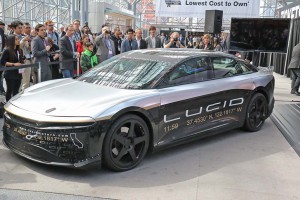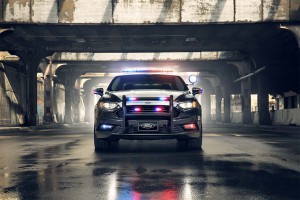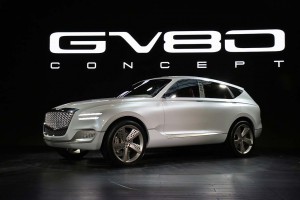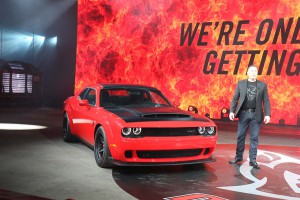
This Lucid Air prototype set a new record pushing 217 mph on a track using electric motors on each axle.
Performance and muscle cars dominate the New York International Auto Show this year, with everything from the 840-horsepower, wheelie-popping Dodge Demon to the more subtle but equally jaw-dropping Koenigsegg Agera RS1, at 1,360-horsepower, making their debut at the Jacob Javits Convention Center.
There are high-performance SUVs, exotic sports cars, coupes and, well, just about everything that you can imagine. Perhaps that’s no surprise considering the fact that gas remains cheap and the Trump Administration is hinting it may roll back the aggressive fuel-economy mandates that were expected to rise to 54.5 mpg by 2025.
But while the green machines that have had such a high-profile presence at the New York International Auto Show in recent years may be taking a back seat, they are far from gone entirely. In fact, some of the more intriguing debuts during this past week’s media preview show that environmentally friendly vehicles are becoming even more of a presence than ever.
Yes, even the most powerful models qualify. The Dodge Demon may be the world’s quickest factory muscle car, capable of launching from 0 to 60 in a mere 2.3 seconds, “but we also meet the latest emissions standards,” bragged Tim Kuniskis, head of North American passenger cars for Fiat Chrysler Automobiles.
(EV maker Lucid shows power and punch capable in its first offering. Details? Click Here.)
The Demon punches out an astounding 840 horsepower. But the Lucid Air sedan that’s also on display at the Javits Center bests that, making a full 1,000 horsepower from a pair of twin electric motors, one on each axle.
Gone are the days when hybrids, plug-ins and pure battery-electric vehicles, or BEVs, were slow and anything but fun to drive. Several models at this year’s NYIAS, notably including the Lucid Air, reveal just how much fun green cars can be.
The Lucid Air also is expected to offer an autonomous driving mode when it comes to market in 2019. And for those in the rear seat, they’ll travel in business jet comfort. Because the batteries are mounted in the floor, and the motors on the axles, the compact sedan offers an interior as big as a long-wheelbase Mercedes-Benz S-Class.
A prototype of the Lucid Air just topped 217 mph during a test run. Try that on the street and you might get pulled over by another model making its debut in NY. The Ford Fusion Police Responder Hybrid shows that even the blues can go green. It starts out as a standard gas-electric Fusion sedan, but the powertrain is specially modified so that it runs clean, quiet and efficiently when idling or cruising – with a combined fuel economy rating of 38 mpg.
When the officer behind the wheel goes into pursuit and slams down the throttle, all bets are off. The electric drive system kicks in a burst of power, making the Responder as quick as the classic V-8-powered Ford Crown Victoria police cruiser. Top speed “well over 100 mph,” says a member of the team that developed the Fusion Hybrid cop car.
(Click Here for a look at the hydrogen-powered future with the Genesis GV80.)
The consensus is that there will be no single “silver bullet,” no one green solution in the immediate future, so automakers are trying out a variety of different alternative powertrain solutions, including conventional hybrids, plug-ins, pure battery-electric models and hydrogen fuel-cell vehicles, or FCVs, as well.
Honda has decided to offer three different takes of its new Honda Clarity model sedan. The fuel-cell version recently went on sale in limited parts of California, where hydrogen is now available at some service stations. It is the third FCV on the retail market, joining the Toyota Mirai and the Hyundai Tucson FCV.
For New York, Honda is adding two more versions of the Clarity to appeal to different segments of the emerging green machine market. That includes the Clarity Electric, a pure battery-electric vehicle with a modest 80-mile range, as well as the Honda Clarity Plug-in Hybrid. Expected to be the best-seller in the group, the PHEV can travel up to 40 miles on battery power alone before its internal combustion engine fires up, letting the Clarity can keep going as long as there’s gas in the tank.
Genesis, Hyundai’s new luxury brand, also is going green for the 2017 NYIAS. And its Genesis GV80 Concept vehicle offers one of the show’s more unusual drivetrains. It’s a plug-in hydrogen design. The primary source of power comes from a lithium-ion battery pack. But when the batteries are drained, the fuel-cell system powers up, allowing the GV80 show car to keep driving.
While there are currently few U.S. hydrogen pumps, the fuel does have its advantages. It can provide 100s of miles of range, and an FCV’s tank can be refilled in less than five minutes.
(To get a look at Ford’s new Fusion Interceptor hybrid, Click Here.)
So, even though performance cars may have muscled their way to the top in New York this year, there are plenty of green alternatives for those who want something a bit more environmentally friendly to drive.



